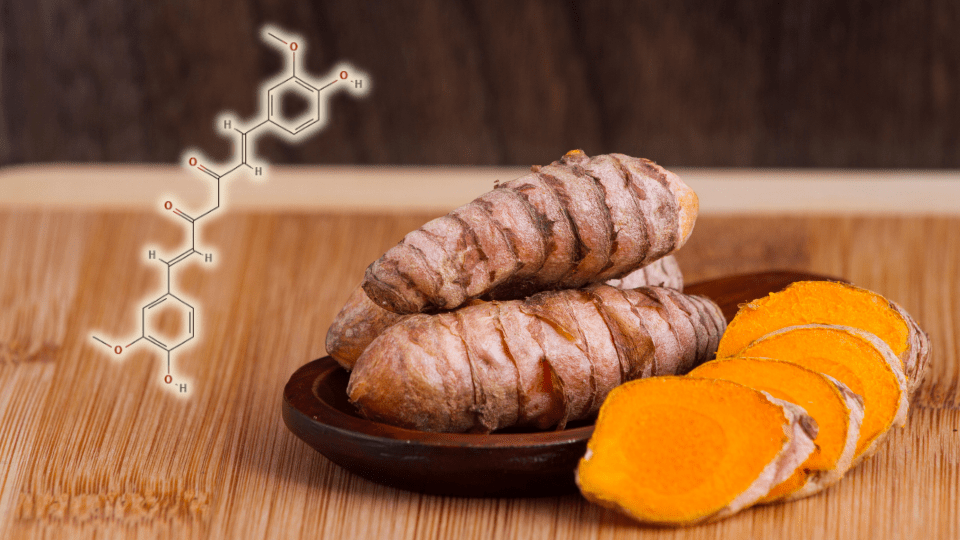Curcumin is the best-known component of turmeric, which has been popular as a " super spice " for years. But does curcumin really work, or is it just a trend? In this article, you'll learn, in a clear and scientifically sound way, which effects of curcumin on the body have actually been proven, what studies indicate, and in which cases taking it might be beneficial. You'll also read why the form of curcumin determines its actual benefits.
Here you will learn...
The most important things in brief
Turmeric vs. Curcumin: Turmeric is the root, curcumin the active ingredient. The fresh root contains only 3-5% curcumin.
The effects of curcumin have been intensively researched in relation to chronic inflammation, joint problems, liver and intestinal health, and metabolic disorders.
Curcumin has great potential, but only in a form that the body can absorb - the right product choice determines the curcumin effect.
Turmeric and curcumin – what is the difference?
Turmeric (Curcuma longa) is a perennial plant from the ginger family. Its bright yellow root is particularly well-known and valued, and is used worldwide as a spice: in curries, golden milk , or as a powder in smoothies or tea.
But turmeric is far more than just a spice. Its root contains curcumin – the plant's most important active ingredient. Curcumin is a polyphenolic compound that gives the root its intense yellow-orange color and its characteristic pungent, slightly bitter aroma. Above all, however, curcumin's effects are associated with turmeric's health-promoting properties.
The catch: The curcumin content in the fresh root is only about 3 to 5 percent. Therefore, the active ingredient is often concentrated and offered in the form of dietary supplements. This allows the effects of curcumin to be used more specifically and effectively (1).
How does curcumin work in the body?
Turmeric has been used for millennia in traditional Indian and Chinese medicine. In Ayurveda, the ancient Indian system of medicine, it is known as Haridra and is particularly valued for its digestive properties (1).
Over time, turmeric found its way into many cultures and is now used worldwide. Modern research also confirms many of the effects traditionally described. Curcumin is a particular focus of this research. Numerous studies show that curcumin can indeed have the positive effects it has long been known to have.

Curcumin effects – what studies say
- Curcumin has demonstrated antioxidant and anti-inflammatory properties in numerous studies (2, 3).
- It has been intensively researched in connection with chronic inflammatory processes – for example, in osteoarthritis (4), intestinal diseases or metabolic disorders (5).
- Curcumin has even been included in medical guidelines for joint problems – a sign of its relevance in research (6).
- Studies show that the effects of curcumin can influence various metabolic processes related to liver and intestinal health (7, 8).
- Curcumin is considered one of the most powerful natural antioxidants . Its antioxidant effect is about ten times stronger than that of vitamin E (1).
Not every turmeric product is equally effective!
The DGOU explicitly emphasizes that only standardized preparations should be used – that is, products manufactured under pharmaceutical conditions and tested for quality. Turmeric from the supermarket or spice aisle is not suitable for therapeutic purposes and should not be taken in high doses (6).

Curcumin's effects - what's the catch?
❌ Pure curcumin is hardly absorbed by the body. Studies show that only a fraction enters the bloodstream; the rest is excreted unused.
❌ Turmeric powder from the supermarket often contains too little curcumin to have a noticeable effect.
❌ Without a specific formulation, the effects of curcumin often fizzle out.
That's why the form of curcumin is crucial.
In order for an active ingredient to function in the body, it must first pass from the intestine into the bloodstream – this process is called bioavailability .
However, this is particularly challenging with regard to the effects of curcumin: it is poorly water-soluble, difficult to absorb in the intestine, and rapidly broken down in the liver.
A large portion is therefore excreted before it can even take effect in the body. This low bioavailability is precisely the main reason why many people do not experience any effects from curcumin despite regular intake.

The solution for better curcumin effectiveness
Numerous studies have addressed the question of which formulations enable better absorption.
The results show that micellar curcumin is significantly superior to conventional preparations. In studies, it was up to 185 times more detectable in the blood (9). Furthermore, micellar curcumin can accumulate in the blood with regular intake and thus remain effective in the body for a longer period (10).

What are micelles?
Micelles are tiny transport spheres that encapsulate fat-soluble substances like curcumin, making them water-soluble. In this form, curcumin can pass through the intestinal wall more easily and is absorbed much better.
In short: Curcumin can only have an effect if it actually reaches the body. Conventional powder has extremely low bioavailability, which is why many users don't experience any effects. If you want to use curcumin that is truly absorbed by the body, then only a modern form like micellar curcumin is suitable.

For whom is curcumin particularly interesting?
The targeted intake of curcumin can be interesting for anyone who wants to support their health naturally. The effects of curcumin have been extensively researched and it is considered a safe substance that rarely causes side effects.
Curcumin can be particularly beneficial in the following cases:
- Support for chronic inflammatory processes
- Supporting liver and intestinal health
- Joint problems such as osteoarthritis
- Metabolic challenges
- General well-being and improved health

How should curcumin be taken?
|
dosage |
Most studies use dosages between 500 mg and 2,000 mg of curcumin per day. With micellar curcumin, significantly lower amounts are often sufficient due to its better bioavailability. Always follow the manufacturer's instructions. |
| Time of day | There's no "perfect" time. You can take curcumin in the morning or evening – whichever best fits into your daily routine. Consistency is key. |
|
Time until effect |
Curcumin is not a quick fix. The first effects of curcumin usually become apparent after 2 to 4 weeks of regular use. For some people, it may take longer – patience is key. |
How to recognize a high-quality curcumin product
- Standardization : The curcumin content should be clearly stated and verified.
- Bioavailability : Look for formulations that improve absorption (e.g., micelle technology, fermentation).
- Manufacturing : Pharmaceutical quality and transparent production conditions are important.
- Additives : The fewer unnecessary additives, the better – especially for sensitive stomachs.
- Certifications : Organic labels, laboratory tests or other quality certificates speak for the product.
- Manufacturer's information : Reputable manufacturers provide clear dosage recommendations and refer to scientific studies.
Our recommendation
Conclusion
Turmeric has been an integral part of traditional healing methods for millennia and is now gaining increasing importance in modern science. Current research findings underscore the promising potential of curcumin's effects .
But one thing is crucial: Curcumin's effects can only unfold if the active ingredient actually reaches the body. Micellar curcumin significantly improves absorption and enables considerably higher bioavailability – for a stronger and longer-lasting effect.
Our expert
What is the difference between turmeric and curcumin?
Turmeric is the whole root of the Curcuma longa plant, while curcumin is the main bioactive ingredient, which makes up only about 3–5% of the root mass and is responsible for many of the health effects.
How well is curcumin absorbed by the body?
Curcumin has low bioavailability due to its poor water solubility and rapid metabolism in the body. Special formulations, such as micellar curcumin preparations, significantly increase absorption and thus improve efficacy.
Can curcumin replace medication?
No. Curcumin can be a supplement, but never a substitute for medically prescribed medication. If you have any health problems, you should always consult your doctor.
Are there any risks or side effects associated with taking curcumin?
Curcumin is generally well-tolerated. Occasionally, sensitive individuals may experience gastrointestinal discomfort. Those with biliary tract disorders should only take curcumin after consulting a doctor.
How long does it take for curcumin to take effect?
Generally, initial effects can be seen after 2 to 4 weeks of regular use. For some people it may take longer – patience and consistency are important.
Is turmeric powder from the supermarket just as effective as a supplement?
No. Turmeric powder from the supermarket contains only about 3 to 5 percent curcumin and has very poor bioavailability. For therapeutic purposes, standardized, high-dose preparations with improved absorption are necessary.
When is the effect of curcumin strongest?
Curcumin's effects are best achieved with regular, long-term intake over several weeks. Bioavailability plays a crucial role – the active ingredient can only exert its full effect if it is optimally absorbed.
References for further reading:
- Abd El-Hack ME, El-Saadony MT, Swelum AA, Arif M, Abo Ghanima MM, Shukry M et al. Curcumin, the active substance of turmeric: its effects on health and ways to improve its bioavailability. J Sci Food Agric 2021; 101(14):5747–62.
- Li H, Sureda A, Devkota HP, Pittalà V, Barreca D, Silva AS et al. Curcumin, the golden spice in treating cardiovascular diseases. Biotechnol Adv 2020; 38:107343.
- Gorabi AM, Abbasifard M, Imani D, Aslani S, Razi B, Alizadeh S et al. Effect of curcumin on C-reactive protein as a biomarker of systemic inflammation: An updated meta-analysis of randomized controlled trials. Phytother Res 2022; 36(1):85–97.
- Zeng L, Yu G, Hao W, Yang K, Chen H. The efficacy and safety of Curcuma longa extract and curcumin supplements on osteoarthritis: a systematic review and meta-analysis. Biosci Rep 2021; 41(6).
- Zheng J, Cheng J, Zheng S, Feng Q, Xiao X. Curcumin, A Polyphenolic Curcuminoid With Its Protective Effects and Molecular Mechanisms in Diabetes and Diabetic Cardiomyopathy. Frontiers in pharmacology 2018; 9:472.
- German Society for Orthopedics and Trauma Surgery (DGHS), ed. Gonarthrosis. 4th ed.; 2024, January 24, 2024. Available at: https://register.awmf.org/de/leitlinien/detail/033-004
- Yao Q, Xu B, Wang J, Liu H, Zhang S, Tu C. Inhibition by curcumin of multiple sites of the transforming growth factor-beta1 signaling pathway ameliorates the progression of liver fibrosis induced by carbon tetrachloride in rats. BMC Complement Altern Med 2012; 12:156.
- Goulart RdA, Barbalho SM, Lima VM, Souza GA de, Matias JN, Araújo AC et al. Effects of the Use of Curcumin on Ulcerative Colitis and Crohn's Disease: A Systematic Review. J Med Food 2021; 24(7):675–85.
- Schiborr C, Kocher A, Behnam D, Jandasek J, Toelstede S, Frank J. The oral bioavailability of curcumin from micronized powder and liquid micelles is significantly increased in healthy humans and differs between sexes. Mol Nutr Food Res 2014; 58(3):516–27.
- Flory S, Sus N, Haas K, Jehle S, Kienhöfer E, Waehler R et al. Increasing Post-Digestive Solubility of Curcumin Is the Most Successful Strategy to Improve its Oral Bioavailability: A Randomized Cross-Over Trial in Healthy Adults and In Vitro Bioaccessibility Experiments. Mol Nutr Food Res 2021; 65(24):e2100613.




Leave a comment
This site is protected by hCaptcha and the hCaptcha Privacy Policy and Terms of Service apply.